If you love chopping fresh veggies in the kitchen, you have probably had moments where your slices came out uneven or your tomatoes turned to mush. That’s where a Nakiri knife can seriously help.
It’s a popular pick among home cooks and chefs for dicing vegetables with a clean, quick finish. Nakiri is not your average chef’s knife with a curved blade for rocking cuts, it’s designed for straight up-and-down chopping for a clean cut with less work.
Wondering why people swear by it? Let’s learn what is a Nakiri knife used for and why it might be a great addition to your kitchen essentials.
What exactly is a nakiri knife?
A Nakiri knife is a traditional Japanese kitchen knife made specifically for vegetables. In fact, its name literally means “leaf cutter” in Japanese.
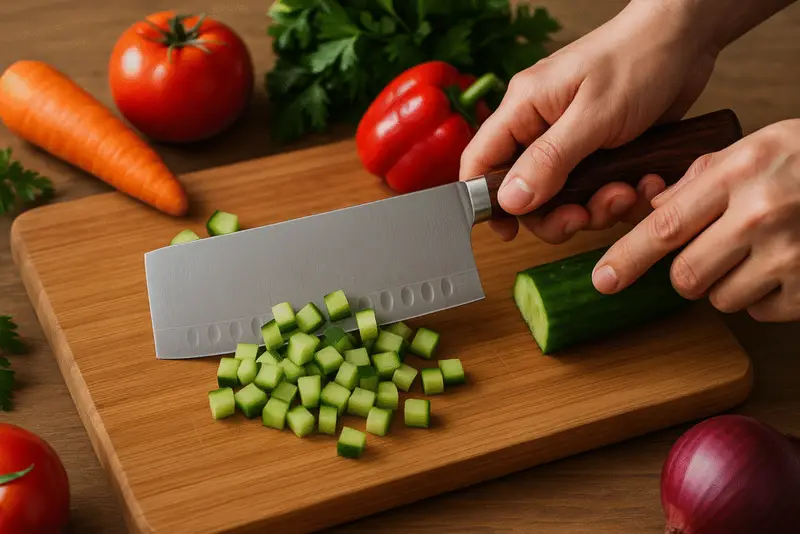
Its standout feature is the rectangular, straight-edged blade that makes precise, straight cuts effortless. Unlike curved knives, it uses a clean chopping motion, making it easier to get even cuts without dragging or pushing the blade through the ingredients.
A special thing about Nakiri knives is their thin, sharp-as-a-tack blade, designed with high-carbon and stainless steel or open-ground stainless steel, keeping them pretty lightweight and balanced.
While some skilled chefs occasionally use them for a light meat prep, Nakiris are strictly meant for veggies. They are not designed for cutting bones, meat, or hard-shelled ingredients. If you use it that way, it can damage the knife, making it dull and difficult to use.
What is a nakiri knife used for?
The Nakiri knife is a go-to favorite in the kitchen for anyone who loves the art of dicing vegetables. With their flat and thin edge, they can handle multiple cutting tasks with accuracy.
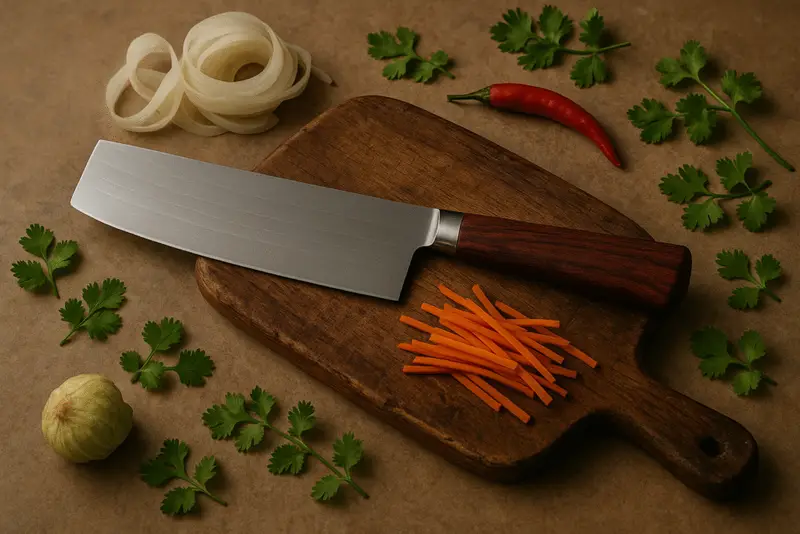
Here’s exactly what to know about different Nakiri knife uses:
1. Chopping vegetables
Nakiri’s straight edge makes way for a clean, even chop without needing to rock the blade. All you need to do is work with it firmly and bring the blade straight down through vegetables like carrots, cabbage, or potatoes. Because the edge stays flat on the board, you get quicker, cleaner prep with every chop.
2. Dicing and mincing herbs
A Nakiri’s knife sharp, thin, and straight-edged blade, makes it great for mincing delicate herbs like parsley, cilantro, or basil. Its flat profile keeps the edge in contact with the cutting board, creating clean, fine cuts without crushing the leaves.
It helps maintain their fresh flavor and appearance. Simply arrange the herbs into a pile and use a quick, up-and-down chopping motion to get smooth results
3. Making decorative cuts (katsuramuki and juliennes)
Did you know Japanese chefs use Nakiri knives for katsuramuki, a technique of peeling veggies into thin sheets? Here, you need to have the vegetable ready and carefully slice the paper-thin layers. You can also make fine juliennes for garnishing dishes or ramen toppings.
4. Slicing firm produce
The thin, sharp blades slice through firm veggies like pumpkin, cucumber, and eggplant without cracking or crushing them. Just use steady, downward strokes to glide through tougher skins and dense interiors.
5. Evenly slicing soft foods
The Nakiri has a thin, sharp, and flat blade that slices through soft foods like tofu and tomatoes without squishing them. Regular knives with thick or jagged edges can crush delicate ingredients, but the Nakiri makes a clean and even cut. It’s great for dishes where neat, smooth slices are needed, like tofu stir-fried or fresh tomato salads.
Things you shouldn’t use a nakiri knife for
As useful as a Nakiri knife is, it’s not an all-rounder. Here’s where you must draw the line when using one:
1. Say no to bone chopping or frozen stuff
When using a Nakiri, steer clear of cutting through bones. The blade is thin and sharp and is strictly meant for veggies. Trying to chop off bones or a frozen block can damage the edge in a snap.
2. Skip the Meats
Nakiri’s aren’t built for slicing through meat or gristle. They don’t have the weight or thickness for it. Better stick with a chef’s knife or cleaver for that.
3. No rocking motion
If you are the one used to Western knife rocking action, fight through the urge. Nakris are made for clean, straight up-and-down cuts. Rocking them back and forth can mess up your cuts and dull the blade faster.
How to maintain a nakiri knife
A Nakiri is easier to ruin than it is to care for. But extra attention and care keep it sharp and ready for years.
1. Use your hands
Never toss a Nakiri in the dishwasher, as the harsh heat and detergent can dull the blade. Just warm water, a soft sponge, and mild soap would do the work.
2. Hone regularly, sharpen occasionall
You can use a honing rod every now and then to keep the edge aligned. If you want full sharpening, you can do it every few months, depending on how frequently you use it.
3. Store it the right way
Avoid throwing the knife in a drawer with other tools. Use a knife block, magnetic strip, or blade to cover and protect the fine edge.
Pro tip: Don’t leave it unattended on a wet counter. Moisture can stain the blade and damage the wooden handles.
Final verdict
Nakiri’s razor-thin, straight edge isn’t limited to clean cuts, it makes prep work smoother, faster, and, frankly more satisfying. You’ll wonder why you ever put up with squishy tomatoes or unevenly sliced veggies.
Sure, it won’t work through bones or frozen cuts, but for veggies, herbs, and delicate food, it’s a knife you’ll reach for more often than you expect. If there’s one knife that simply earns its place in any kitchen, home, or pro, it’s the Nakiri. So, it might be time to see what you have been missing.
FAQs
Why is a Nakiri knife so useful?
A Nakiri knife is designed specifically for veggies. It’s a thin, straight blade that lets you slice cleanly and quickly without damaging delicate greens. It makes chopping faster and sharper, perfect for anyone who loves cooking fresh vegetables.
What things can I cut with a Nakiri knife?
Nakiri knives work well with all kinds of vegetables, think leafy greens, carrots, cucumbers, and even soft tofu. Keep in mind, though, that it’s not built for meat or bones and can get damaged if used for the same.
What is the difference between a Nakiri knife and a Santoku knife?
Both of these are Japanese knives, perfect for veggies. A Nakiri knife has a straight edge for chopping straight down, and a Santoku has a little curved blade for a rocking motion. Also, Nakiris are usually thinner and more well-suited for veggies.
Do I need to sharpen a Nakiri knife differently?
Yes, Nakiris typically have a sharper, thinner edge than most knives. So, they need gentle sharpening with a fine whetstone to keep that sharp edge without ruining the blade.

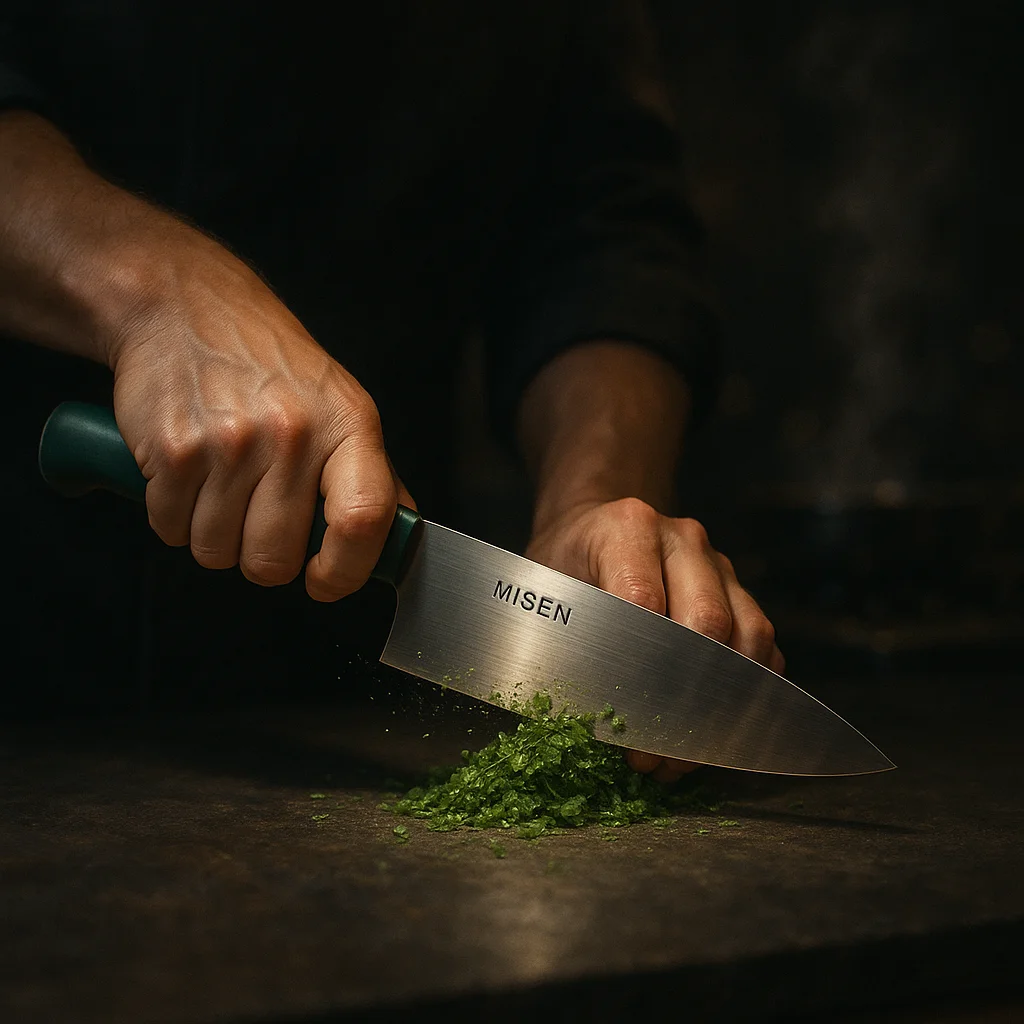
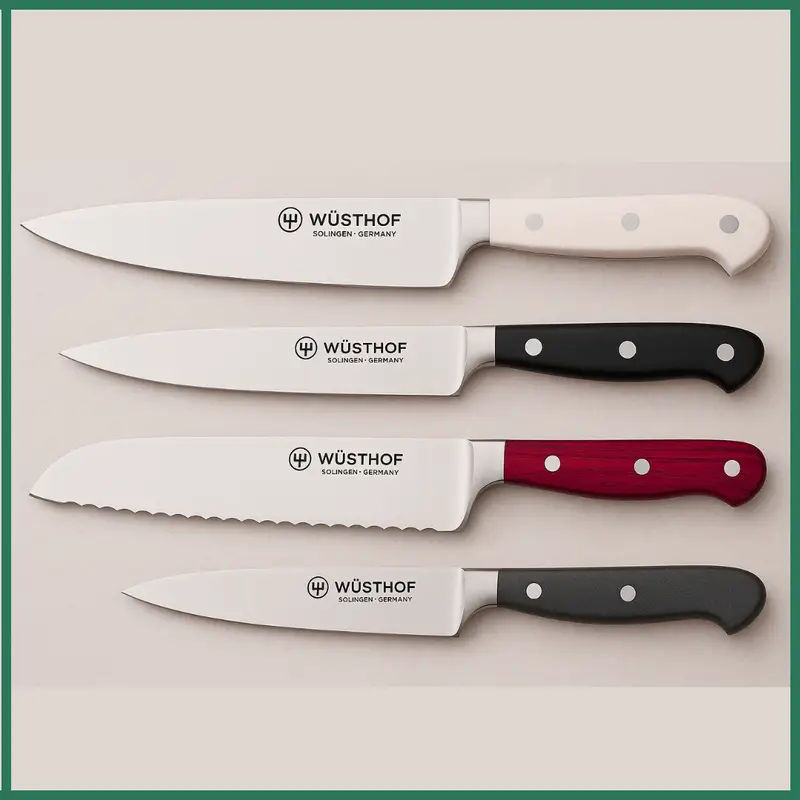
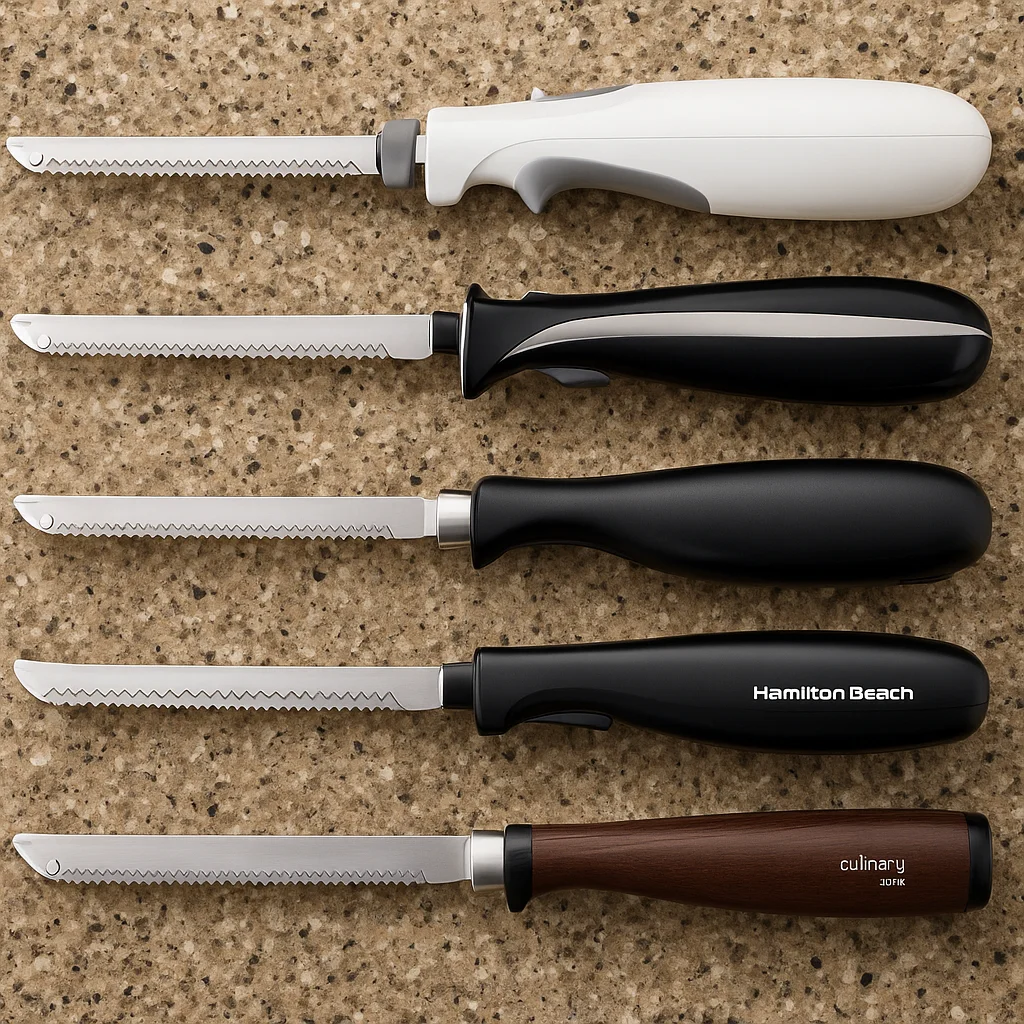
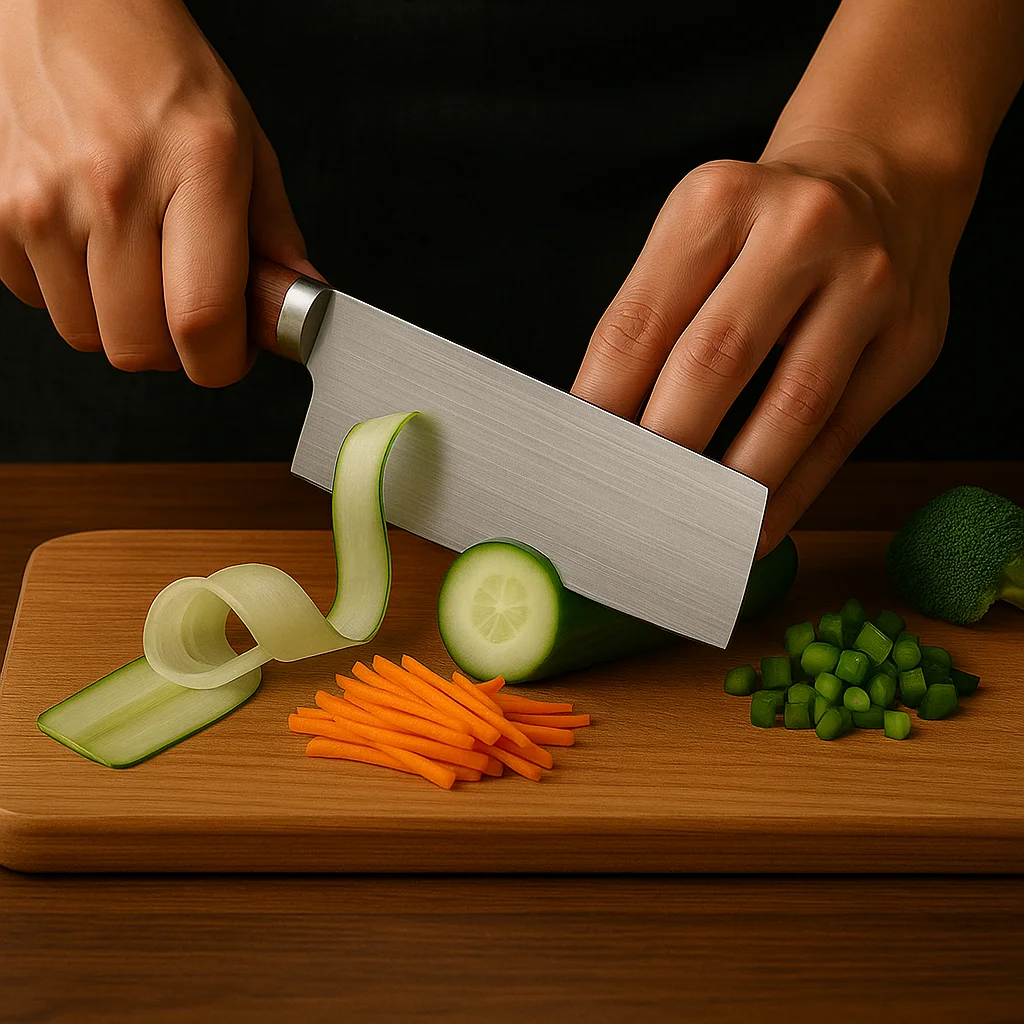
Leave a Reply